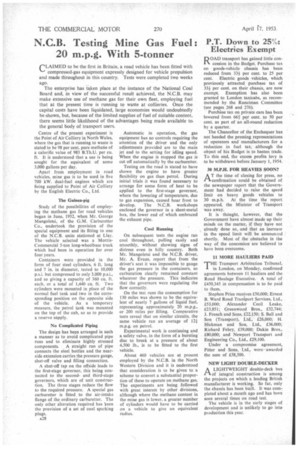N.C.B. Testing Mine Gas Fuel : 20 m.p.g. With 5-tonner
Page 30

If you've noticed an error in this article please click here to report it so we can fix it.
CLAIMED to be the first in Britain, a road vehicle has been fitted with compressed-gas equipment expressly designed for vehicle propulsion and made throughout in this country. Tests were completed two weeks ago.
The enterprise has taken place at the instance of the National Coal Board and, in view of the successful result achieved, the N.C.B. may make extensive use of methane gas for their own fleet, employing fuel that at the present time is running to waste at collieries. Once the capital costs have been liquidated, large economies would undoubtedly be-shown, but, because of the limited supplies of fuel of suitable content, there seems little likelihood of the advantages being made available to the general body of transport users.
Centre of the present experiment is the Point of Air Colliery in North Wales, where the gas that is running to waste is stated to be 98 per cent. pure methane of a calorific value of 983 B.Th.U. per cu. ft. It is understood that a use is being sought for the equivalent of some 3,000 gallons per day.
Apart from employment in road vehicles, mine gas is to be used in five 700 kW. dual-fuel engines which are being supplied to Point of Air Colliery by the English Electric Co., Ltd.
The Guinea-pig
Study of the possibilities of employing the methane gas for road vehicles began in June, 1952, when Mr. George Mangoletsi, of the G.M. Carburetter Co., undertook the provision of the special equipment and its fitting to one of the N.C.B. units stationed at Llay. The vehicle selected was a MorrisCommercial 5-ton long-wheelbase truck which had been in operation for over four years.
Containers were provided in the form of four steel cylinders, 6 ft. long and 7 in. in diameter, tested to 10,000 p.s.i. but compressed to only 3,000 p.s.i., and so giving a capacity of 360 Cu. ft. each, or a total of 1,440 Cu. ft. Two cylinders were mounted in place of the normal fuel tank and two in the corresponding position on the opposite side of the vehicle. As a temporary measure, the petrol Lank was mounted on the top of the cab, so as to provide a reserve sopply.
No Complicated Piping The design has been arranged in such a manner as to avoid complicated pipe runs and to eliminate highly stressed components. A straight run of pipe connects the steel bottles and the nearside extension carries the pressure gauge. shut-off valve and filling connection.
A shut-off tap on the offside leads to the first-stage governor, this being connected to the secondand third-stage governors, which are of unit construction. The three stages reduce the flow to the required pressure. A special gas carburetter is fitted to the air-intake flange of the ordinary carburetter. The only other alteration required has been the provision of a set of cool sparking plugs.
A28 Automatic in operation, the gas equipment has no controls requiring the attention of the driver and the only adjustments provided are to the main jet and to the setting for idling speed. When the engine is stopped the gas is cut off automatically by the carburetter.
Testing on the road is stated to have shown the engine to have greater flexibility on gas than petrol. During initial trials it was found necessary to arrange for some form of heat to be applied to the first-stage governor, where the lowering of temperature, due to gas expansion, caused hoar frost to develop. The N.C.B. workshops enclosed the governor in a sheet-metal box, the lower end of which embraced the exhaust pipe.
Cool Running On subsequent tests the engine ran cool throughout, pulling easily and smoothly, without showing signs of distress even in hilly country. Both Mr. Mangoletsi and the N.C.B. driver, Mr. A. Evans, report that from the driver's seat it was impossible to gauge the gas pressure in the containers, so carburation clearly remained constant whatever the pressure. This indicates that the governors were regulating the flow correctly.
On the test runs the consumption for 130 miles was shown to be the equivalent of nearly 7 gallons of liquid fuel, representing approximately 20 m.p.g., or 200 miles per filling. Comparative tests reveal that on similar circuits, the same vehicle ran an average of 12i m.p.g. on petrol.
Experimental work is continuing and a safety valve, in the form of a bursting disc to break at a pressure of about 4,500 lb., is to be fitted to the first vehicle.
About 460 vehicles are at present employed by the N.C.B. in the North Western Division and it is understood that consideration is to be given to a scheme to convert a substantial proportioa of these to operate on methane gas. The experiments are being followed with great interest by other divisions, although where the methane content in the mine gas is lower, a greater number of cylinders would have to be carried on a vehicle to give an equivalent radius.




















































































